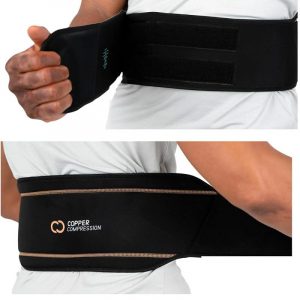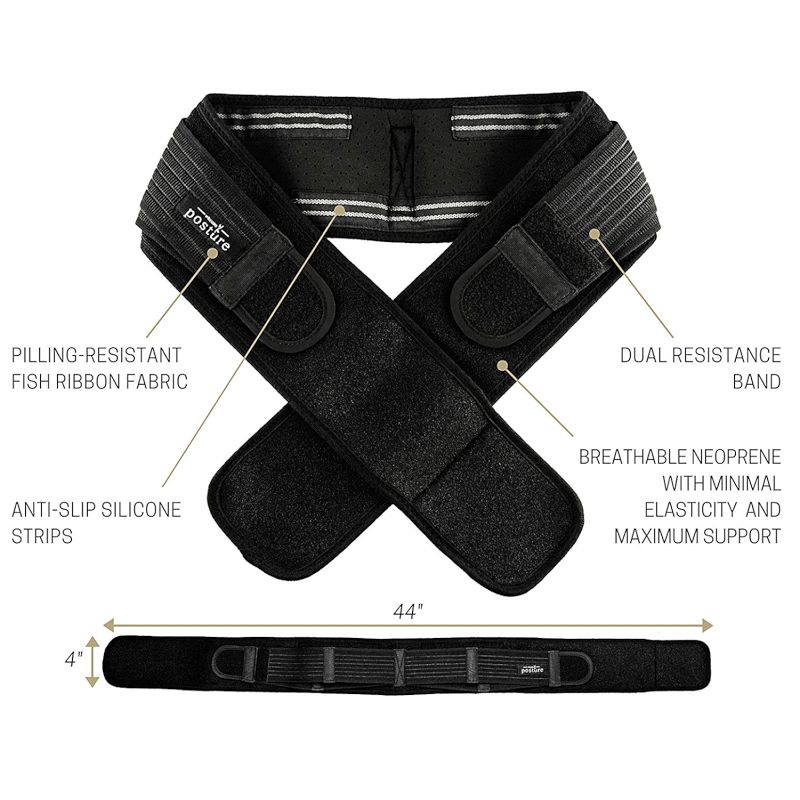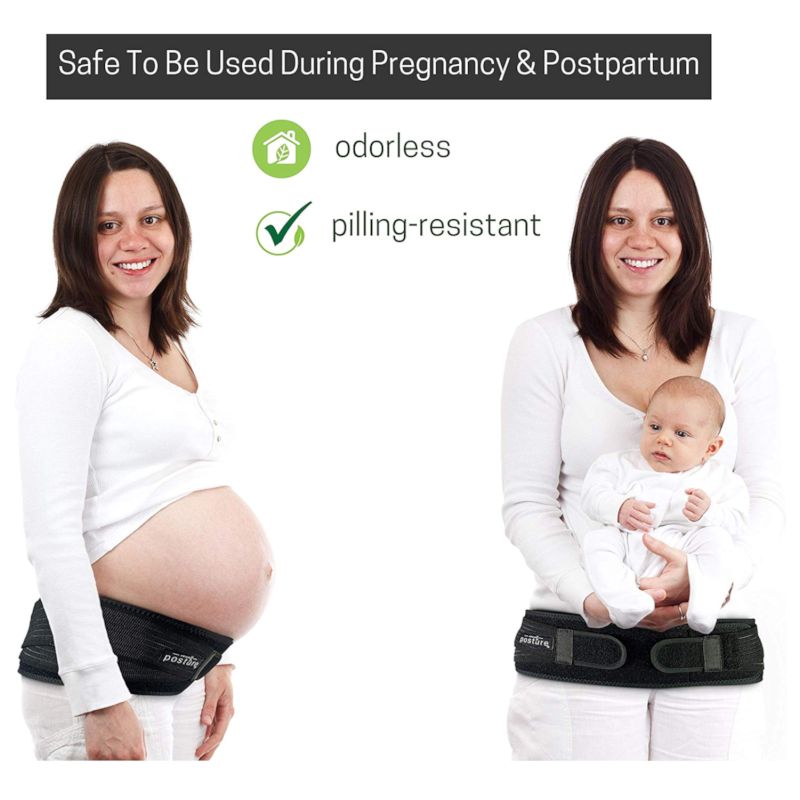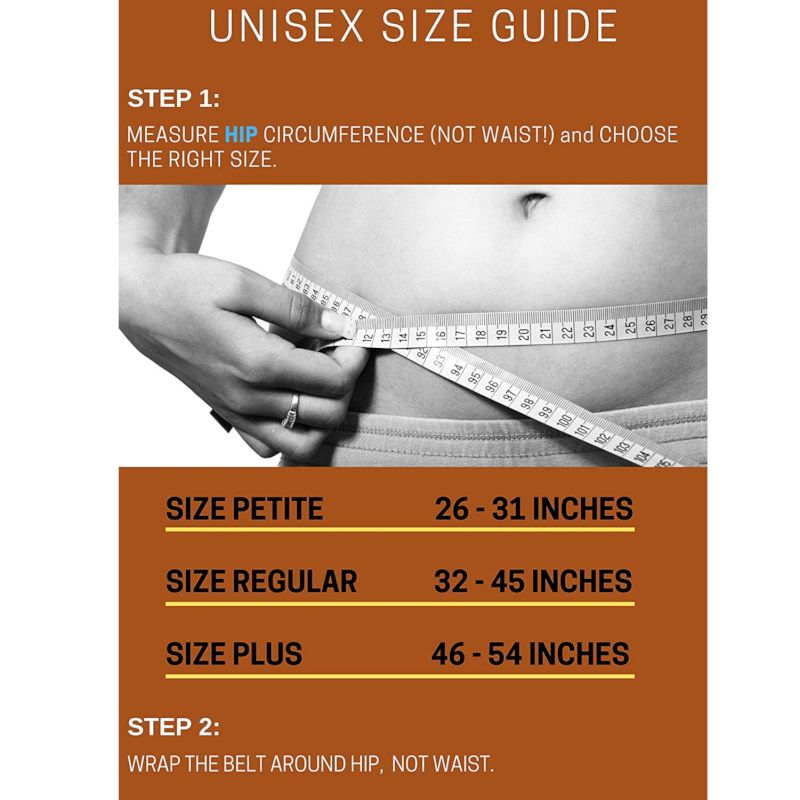Pelvic Belt
$35.00 Original price was: $35.00.$25.99Current price is: $25.99.
Pelvic belt for sacroiliac pain is an effective way to reduce pregnancy related pelvic pain as well as back pain
Designed to compress and support the sacroiliac joints. SI belt supports the sacroiliac joints relieving stress and instability. Breathable, moisture-wicking, and hypoallergenic.
Prices & Offers Subject To Change
This Pelvic Belt Compresses & Supports The Sacroiliac Joints (SI Joints), Thus Relieving Instability & Stress
It is not restrictive and will not cause muscle wasting. The pelvic belt helps balance the pelvis by stabilizing the joints which can become unstable due to injury, postural imbalance and metabolic factors like during pregnancy.
The elastic sacroiliac belt establishes more normal joint motion and helps with pain from excessive motion. Because it stabilizes the base of the spine, The benefits can be felt in the back, hips and legs. With SI Joint problems, this belt can help reduce pain and risk of further injury and inflammation.
This is a great pelvic belt and has layers; the first is changed an open cell foam that is breathable, comfortable, moisture wicking, and hypoallergenic, enabling it to be worn directly on the skin. It also permits better molding to the anatomy, and the material allows a better grip to prevent slippage.
How To Use SI Belt
With hip or back pain that has not responded to targeted therapy, you might have dysfunction of the sacroiliac joint. This can often be missed as a diagnosis. As a chiropractor, it has always been a focus of attention towards diagnosis and treatment in consideration of the lumbo-pelvic complex.
Pelvic Belts & Pregnancy
I treated my first pregnant patient, the daughter of a medical doctor who, out of desperation sent her to me. The stress was mainly in the facet joints of the lower lumbar spine. I was able to adjust her in a sitting position and release the joints, which would lock.
The release proved very effective and I was able to manage her throughout her pregnancy. This lead to many referrals. As most women will tell you, every pregnancy is different. This is true and the causes of pain and discomfort varied.
Often, a pelvic belt would prove beneficial. It is an important and necessary feature of pregnancy that these joints loosen in preparation for delivery. The stress is produced by the increase in gravitational forces as the baby grows. The increase in horizontal weight alters the posture in a hyper-lordotic position of the lumbar spine, which stresses the muscles, joints as well as the sacroiliac joints.
These were often addressed according to the circumstances. Sitting adjustments, supine (back lying) myofascial work, and table work with a drop abdominal piece provided more specific work and flexion distraction.
Sometimes a pelvic belt was very helpful. Other instances a maternity belt would help reduce gravitational forces enough to relieve the back muscles spasms. For some, a combination of the two belts was necessary. Body pillows can also provide additional support when sleeping or relaxing. After pregnancy, when stabilization during recovery is crucial, the elastic sacroiliac belt can really help.
Pelvic Belt & Hip Pain
Hip pain can be complex. Since the hips attach to the pelvis, there are a number of factors which relate to direct hip pain and back, groin and leg pain. When these type of symptoms arise, arthritis must be ruled out, along with any trauma related to injury, such as fractures.
Often, with discomfort and limited mobility that is felt in the back, the si joints can be involved as well as the psoas muscles that connect between the hip, pelvis and lumbar spine.
The SI Joint Belt can help as an external ligament, keeping the joints in normal range of motion, alleviating compensatory muscle reaction. When the belt keeps stability, muscles may relax and spasm can be significantly reduced. This is sometime the case with an SI Joint Belt, where the pain can reduce significantly in a short period of time.
Don’t expect these results as they are not typical. Even with a confirmed sacroiliac joint diagnosis, things will need to settle down and inflammation reduced before addressing some of the possible causes can be addressed. Usually, the belt will have a positive effect.

Studies Validate The Effectiveness Of A Pelvic Belt
In a 2017 study in the Journal of Physical Therapy Science, it was concluded that a pelvic compression belt may be appropriate for patients with pelvic pain and lower back pain related to pregnancy. The found a significant reduction of angular displacement and moment at the hip joint when standing from a sitting position. The authors indicated that a pelvic belt can also be recommended for those who do not have symptoms, but have difficulty in standing up effectively.
A 2013 study in the journal Manual Therapy found a pelvic compression belt improved activation patterns of sacroiliac joint pain patients related to the hip extensors, significantly reducing EMG amplitude of the biceps femoris and gluteus maximus. The authors recommended use of a pelvic compression belt to modify activation patterns in patients with sacroiliac joint pain.
A 2015 study in the journal PLoS One concluded pelvic belts improve quality of life and are a “cost-effective and low-risk treatment of SIJ [sacroiliac joint] pain.” The authors further noted improved postural steadiness, pain reducing effect, and improved locomotion and muscle activation patterns with chronic sacroiliac joint dysfunction.
A comprehensive 2017 article in the Journal of Neuroscience in Rural Practice delineates the specific details of sacroiliac joint problems and treatment. The authors indicate sacroiliac joint pain may also cause lower back and gluteal region pain in 15% of the population, indicating a public health issue relating to great implications on the quality of life and health related costs.
The authors noted that sacroiliac pain is a cause of axial lumbar pain in 15 to 25% of cases. This is enormous considering two thirds of the adult population suffers from back pain. They indicate that conservative treatment is based on stabilization of sacroiliac joint, and sacroiliac belts can be strategic to stabilization. The authors state, “Sacroiliac pain is the second most common cause of visits to the neurologist in the US, after a headache.”
Related products
-


Back Brace
$49.97 Place This Order on Amazon -
 Sale!
Sale!

Back Pain Belt
$61.99Original price was: $61.99.$51.99Current price is: $51.99. Place This Order on Amazon -
 Sale!
Sale!

Copper Belt
$38.95Original price was: $38.95.$21.95Current price is: $21.95. Place This Order on Amazon -


Active Seat
$19.99 Place This Order on Amazon






